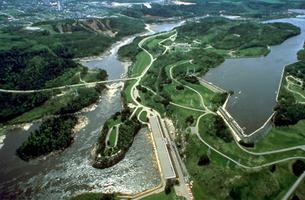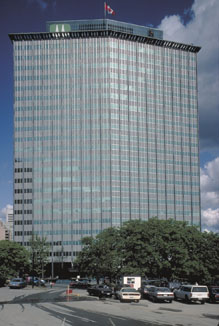Hydro-Québec, a provincially owned corporation based in Montréal, is Canada's largest electric utility and, judged by assets ($30.6 billion in 1986), Canada's second largest corporation. More than 95% of its production is from renewable hydroelectricity. First created as a legal entity in 1944, Hydro-Québec did not become a major force until the early 1960s. René Lévesque, then resources minister in the Liberal government of Jean Lesage, oversaw the nationalization of the province's larger private electrical utilities. In the late 1970s and early 1980s, Parti Québécois governments led by Lévesque further reorganized Hydro-Québec. The utility enjoys formidable economic advantages: once dams are in place, operating costs are very low; furthermore, it has a contract to buy power from the Churchill Falls project in Labrador at 1969 prices until the year 2041. Hydro-Québec can thus underbid Ontario Hydro in the US export market, provide cheap power within Québec and still pay a dividend to the provincial government. In March 1998 premiers Brian Tobin and Lucien Bouchard announced that Newfoundland and Labrador Hydro and Hydro-QuÉbec would negotiate an agreement for the development of 3200 MW of additional power from the Churchill River system. The arrangement would include the expansion of the existing Churchill Falls project through the partial diversion of two Québec rivers, the Saint-Jean and the Romaine, into the Smallwood Reservoir. The utilities also negotiated the details of the Gull Island development on the Lower Churchill. A 2200 MW generating station, containing eight 283 MW generators, will be constructed. Two 735 kV transmission lines, one from Gull Island to Churchill Falls, and a second from Gull Island to Québec, will also be built and the cost rolled in to the Québec grid. The benefits to Newfoundland will include 1000 MW of hydro-electric power to consumers in Newfoundland and Labrador, the full benefit of higher market prices, other projects and payments to Newfoundland, and considerable employment.
Québec's first hydroelectric-generating stations were built by private entrepreneurs at the end of the last century. In 1903 N America's first long high-voltage transmission line was placed in service. The 50 kV line ran 135 km from the Shawinigan powerhouse to Montréal. Although the new industry attracted many entrepreneurs, regional monopolies soon dominated the market. Responding to public criticism of poor service and high rates, the Québec government expropriated Montreal Light, Heat and Power Consolidated and its subsidiary, Beauharnois Light, Heat and Power Co, and empowered the Québec Hydro-Electric Commission to administer these 2 companies. Thus, Hydro-Québec was born on 14 Apr 1944.
On 1 May 1963 Hydro-Québec extended its activities to cover the whole province. It purchased the shares of nearly all remaining privately owned electrical utilities then operating in Québec and took over their debts. The total amount involved was $600 million. Hydro-Québec subsequently undertook construction of the Manic-Outardes hydroelectric complex. The project's Daniel Johnson dam is the world's largest arch-and-buttress dam; its Manic 2 is the largest hollow-joint gravity dam. In order to transmit the complex's annual production of about 30 billion kWh over a distance of nearly 700 km, Hydro-Québec had to innovate. It became the first utility in the world to transmit electricity at 735 kV. Since then, its research institute, created in 1967, has pursued intensive research in electric-power transmission. In the early 1970s Hydro-Québec embarked on the James Bay Project. Completed in 1986, James Bay's LG-2, LG-3 and LG-4 power stations added 10 282 MW to Hydro-Québec's generating capacity. In Dec 1987, Hydro-Québec signed its first long-term sales contract, with Vermont Joint Owners, to export surplus electricity to the United States.

 Share on Facebook
Share on Facebook Share on X
Share on X Share by Email
Share by Email Share on Google Classroom
Share on Google Classroom





